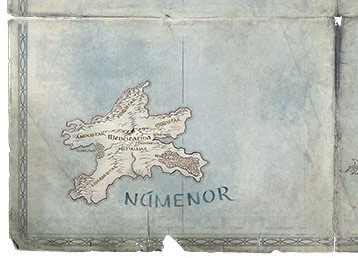
“But in the end, it’s only a passing thing, this shadow; even darkness must pass.” – Samwise Gamgee, The Lord of the Rings: The Two Towers
The world currently finds itself in strange and somewhat scary times right now. It’s hard to turn anywhere without hearing about the global coronavirus pandemic, and like most things, COVID-19 has also had substantial impacts on the production schedules of some of the world’s biggest and most anticipated film and television projects.
Amongst those, none are probably larger or more anticipated than the upcoming billion-dollar production of the Lord of the Rings television series that was, until recently, being filmed in New Zealand by Amazon. Around 800 cast and crew were stood down from production on March 16 and, according to a memo circulated by the production heads, “there are no clear answers as to when [they] will resume production.”
On this most unusual #TolkienReadingDay, all of us at #LOTRonPrime send you wishes of comfort and safety. pic.twitter.com/5rgWyEHwUs
— The Lord of the Rings on Prime (@LOTRonPrime) March 25, 2020
Like Frodo’s loyal companion, though, we have faith that dark times will pass, and the world will return to normal once this pandemic passes into the history books. So in the meantime, whilst we patiently wait to hear more optimistic news, why don’t we take a look at what we can expect from the show once production kicks back in?
The Show’s Setting
Amazon has let slip that its series will be set during the Second Age of Tolkien’s sprawling fantasy world, a period in Middle-earth’s history which ended some 3,000 years before Frodo Baggins and Samwise Gamgee climbed their way to the peak of Mount Doom and destroyed Sauron’s ring of power. Thanks to a map released by Amazon Prime’s official LoTR Twitter account, we know that the Middle-earth we’ll see is going to be a considerably different place than which we saw in the films helmed by Kiwi director Peter Jackson, and whilst some familiar locations still existed at that time, there is bound to be a lot more for audiences to explore for the first time on screen.
One Ring to rule them all, One Ring to find them, One Ring to bring them all, and in the darkness bind them, In the Land of Mordor where the Shadows lie. #LOTRonPrime pic.twitter.com/7TuQh7gRPD
— The Lord of the Rings on Prime (@LOTRonPrime) March 7, 2019
So what is a Lord of the Rings TV series without Frodo and his hairy toed friends actually going to focus on? Let’s take a look at what we already know about the Second Age from Tolkien’s original writings and explore the Middle-earth that we’re likely to encounter once the show hits our screens.
Fans of the films directed by Peter Jackson will recall the opening of The Fellowship of the Rings in which an epic showdown with the final alliance between Men and Elves saw the Dark Lord Sauron and his Orcish hordes defeated. When Isildur took up the broken sword of his father Elendil, and cut the one ring from Sauron’s hand, not only was the first War of the Ring won, but 3,441 years of rich history came to a close and the Second Age gave way to what would become the Third Age.

The Battle of Dagorlad
So that leaves Amazon with a good three millennia of potential events to play around with, many of which are not as anywhere as well documented as the events of the Third Age (which includes the events depicted in The Hobbit and The Lord of the Rings), or the First Age (which is covered in some depth in the writings which comprise The Silmarillion). That being said, there were some very important things that happened during that time that we’ll most likely see make their way into the show.
The Forging of the Great Rings and the Creation of the Ring Wraiths
Before he liked getting about in decidedly uncomfortable, spiky, metal armour, the Dark Lord Sauron was actually a primordial spirit known as a Maiar — five of whom would later be incarnated as the Istari, or the five wizards of the Third Age. Anyway, Sauron (or Mairon “the Admirable” as he used to be known once), would fall under the influence of Middle-earth’s First Dark Lord, Morgoth. When Morgoth himself was defeated at the end of the First Age, Sauron eventually fled and laid low for a few hundred years before hatching a devious plan.
Disguising himself in the beautiful form of Annatar, the “Lord of Gifts”, he sought out the Elvish smiths of Eregion (what used to be the Elvish kingdom ruled by Galadriel and her husband Celeborn before they founded Lothlórien). Using his disguise, he was able to impart his knowledge of magic to the Elvish smith Celebrimbor, and convinced him to make 16 rings of power. Knowing they were easily corruptible, Sauron gave the first nine of those rings to the Kings of mortal men, turning them into great sorcerers.

Dark Lord Sauron
Gifted with the most evil-hearted of the great rings, the nine kings were all easily corrupted and eventually turned into Sauron’s most feared servants, the Nazgûl or Ring Wraiths.
The other seven rings, Sauron gifted to the Kings of the Dwarves. Whilst Dwarvish hearts were far stouter and less corruptible than men’s, the rings did imbue many Dwarves with an insatiable lust for gold (which would come to play a big role in the events of The Hobbit). Apart from one Dwarvish ring worn by Thorin’s father Thrain, very little is known about the history of the Dwarvish rings.
Celebrimbor would eventually forge the three Elvish rings by himself, after Sauron departed from Eregion, hence they did not contain any trace of his evil. Though they would, however, still come to be bound by Sauron’s own One Ring through the magic he had imparted to their maker.
The Rise and Fall of Númenor
Take a closer look at the map of the Second Age of Middle-earth and you might notice the massive five-pointed island named Númenor which is conspicuously absent from the geography of the Third Age. This is because the island Kingdom of Númenor quite literally rose from and fell back into the ocean during that time.
 During the war against Morgoth in the First Age, a large part of Middle-earth named Beleriand was destroyed in the conflict. As recompense, the Valar (God-like beings) raised the island from the Great Sea as a new home for those who had been displaced. The only caveat the Valar gave the men of Númenor for their new home was that they were forbidden from sailing too far west, where the Undying Lands that men are forbidden to visit lay.
During the war against Morgoth in the First Age, a large part of Middle-earth named Beleriand was destroyed in the conflict. As recompense, the Valar (God-like beings) raised the island from the Great Sea as a new home for those who had been displaced. The only caveat the Valar gave the men of Númenor for their new home was that they were forbidden from sailing too far west, where the Undying Lands that men are forbidden to visit lay.
At first, the men of Númenor tried to compensate for this ban by sailing east instead, and they colonised much of Middle-earth as they did so, creating a massive maritime empire. Toward the end of the Second Age, the 25th King of Númenor, Ar-Pharazôn the Golden, sailed to Middle-earth with such a great force that Sauron himself surrendered. Sauron, however, poisoned Ar-Pharazôn’s mind and installed himself as an advisor who had the king build a temple to Morgoth and begin human sacrifices. It was at this time that the White Tree of Númenor was cut down and burnt in the temple, though a seedling of the tree was saved by Isildur (whose father Elendil was the leader of a small group of Númenorians who remained faithful to the Valar) and it was eventually taken to the mainland and replanted in what would become the Kingdom of Gondor.
Meanwhile, Sauron had managed to twist Ar-Pharazôn’s mind so far that he convinced him to defy the Valar and sail west with an armada aimed at seizing control of the forbidden Undying Lands. The Valar didn’t take too kindly to Ar-Pharazôn’s betrayal or presumption, and reshaped the world from being flat to being round and sunk Númenor back into the sea. Elendil’s faithful survived the sinking of Númenor and sailed to Middle-earth and came to be known as the Dúnedain, whilst Sauron lost his physical form and his ability to take on beautiful and deceptive appearances, and his spirit fled back to Middle-earth to take up residence in Mordor.
The Last Alliance of Elves and Men

Fangorn Forest
A little over a century or so after the sinking of Númenor (which is like a blink of the eye to the Elves and long-lived Dúnedain), the threat of Sauron was far too great to ignore and an alliance was struck between Elendil and the Elvish King Gil-galad. The great alliance spent years gathering arms and forces to attack Sauron’s might, and they spent a whole three years in Elrond’s Rivendell just making enough weapons for everyone—this is the reason that Rivendell is also known as “The Great Forge”.
When the alliance’s force finally moved on Sauron, they encountered their first battle in Fangorn Forest, where Sauron had sent an advanced host to destroy the Entwives who resided there. The main deciding battle in the conflict, however, would take place on the fields of Dagorlad where Sauron’s force was obliterated and the Black Gate thrown down. Unlike the movie, though, Sauron would continue to hold up in his fortress of Barad-dûr and settle in for a siege which lasted seven years.
Eventually, Sauron came forth and fought both Gil-galad and Elendil in combat, slaying both before Isildur cut the ring from his finger and dispersed his spirit, thus ending the war and the Second Age in one lucky strike.
When can we expect to see the series?
Even before production was put on hold, there was no official word as to when the series would premiere, though it was widely expected to hit screens in 2021. As to how long production delays due to shutdowns will last or impact this release remains to be seen, in the meantime “all we have to do is decide what to do with the time that is given to us”.
And, if you currently find yourself in lockdown, perhaps a Lord of the Rings extended edition marathon just might be in order.









